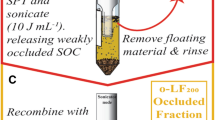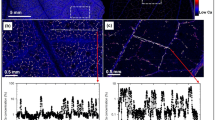Abstract
Termites and soil calcium carbonate are major factors in the global carbon cycle: termites by their role in decomposition of organic matter and methane production, and soil calcium carbonate by its storage of atmospheric carbon dioxide. In arid and semiarid soils, these two factors potentially come together by means of biomineralization of calcium carbonate by termites. In this study, we evaluated this possibility by testing two hypotheses. Hypothesis 1 states that termites biomineralize calcium carbonate internally and use it as a cementing agent for building aboveground galleries. Hypothesis 2 states that termites transport calcium carbonate particles from subsoil horizons to aboveground termite galleries where the carbonate detritus becomes part of the gallery construction. These hypotheses were tested by using (1) field documentation that determined if carbonate-containing galleries only occurred on soils containing calcic horizons, (2) 13C/12C ratios, (3) X-ray diffraction, (4) petrographic thin sections, (5) scanning electron microscopy, and (6) X-ray mapping. Four study sites were evaluated: a C4-grassland site with no calcic horizons in the underlying soil, a C4-grassland site with calcic horizons, a C3-shrubland site with no calcic horizons, and a C3-shrubland site with calcic horizons. The results revealed that carbonate is not ubiquitously present in termite galleries. It only occurs in galleries if subsoil carbonate exists within a depth of 100 cm. 13C/12C ratios of carbonate in termite galleries typically matched 13C/12C ratios of subsoil carbonate. X-ray diffraction revealed that the carbonate mineralogy is calcite in all galleries, in all soils, and in the termites themselves. Thin sections, scanning electron microscopy, and X-ray mapping revealed that carbonate exists in the termite gut along with other soil particles and plant opal. Each test argued against the biomineralization hypothesis and for the upward-transport hypothesis. We conclude, therefore, that the gallery carbonate originated from upward transport and that this CaCO3 plays a less active role in short-term carbon sequestration than it would have otherwise played if it had been biomineralized directly by the termites.





Similar content being viewed by others
References
Arshad MA (1981) Physical and chemical properties of termite mounds of two species of Macrotermes (Isoptera, Termitidae) and the surrounding soils of semiarid of Kenya. Soil Sci 132:161–174
Asawalam DO, Osogdeke VE, Kamalu OJ, Ugwa IK (1999) Effects of termites on the physical and chemical properties of the acid sandy soils of southern Nigeria. Commun Soil Sci Plant Anal 30:1691–1696
Birdsey RA, Lewis GM (2003) Carbon in U.S. forests and wood products, 1987–1997: state-by-state estimates. USDA Forest Service General Technical Report NE-310, Newtown, Pennsylvania
Boutton TW (1991) Stable carbon isotope ratios of natural materials: I. Sample preparation and mass spectrometric analysis. In: Coleman DC, Fry B (eds) Carbon isotope techniques. Academic Press, Inc., New York, pp 155–171
Buffington LC, Herbel CH (1965) Vegetation changes on a semidesert grassland range. Ecol Monogr 35:139–164
Conley W., Conley MR, Karl TR (1992) A computational study of episodic events and historical context in long-term ecological process: climate and grazing in the northern Chihuahuan Desert. Coenoses 7:55–60
Craig H (1957) Isotopic standards for carbon and oxygen and correction factors for mass spectrometric analysis of carbon dioxide. Geochim et Cosmochim Acta 12:133–149
Eswaran H, Reich PF, Kimble JM, Beinroth FH, Padmanabhan E, Moncharoen P (2000) Global carbon stocks. In: Lal R, Kimble JM, Eswaran H, Stewart BA (eds) Global climate change and pedogenic carbonates. Lewis Publishers, Boca Raton, pp 15–26
Follett RF, Kimble JM, Lal R (2001) The potential of U.S. grazing lands to sequester carbon and mitigate the greenhouse effect. Lewis Publishers, Boca Raton
Gibbens RP, McNeely RP, Havstad KM, Beck RF, Nolen B (2005) Vegetation change in the Jornada Basin from 1858 to 1998. J Arid Environ 61:651–668
Gile LH (1975) Causes of soil boundaries in an arid region; II. Dissection, moisture, and faunal activity. Soil Sci Soc Am Proc 39:324–330
Gile LH, Peterson FF, Grossman RB (1966) Morphological and genetic sequences of carbonate accumulation desert soils. Soil Sci 101:347–360
Gile LH, Ahrens RJ, Anderson SP (2003) Supplement to the Desert Project Soil Monograph, vol III. Soil Survey Investigations Report No. 44. U.S. Department of Agriculture, Natural Resources Conservation Service, Lincoln, NE
Grossman RB, Ahrens RJ, Gile LH, Montoya CE, Chadwick OA (1995) Areal evaluation of organic and carbonate carbon in a desert area of southern New Mexico. In: Lal R, Kimble JM, Levine E, Stewart BA (eds) Soils and global change. Lewis Publishers, Boca Raton, pp 81–92
Houghton J (2004) Global warming—the complete briefing. Cambridge University Press, Cambridge
Khalil M, Rasmussen RA, French JRJ, Holt JA (1990) The influence of termites on atmospheric trace gases—CH4, CO2, CHCl3, N2O, CO, H2, and light-hydrocarbons. J Geophys Res 95:3619–3634
Kimble JM, Heath LS, Birdsey RA, Lal R (2003) The potential of U.S. forest soils to sequester carbon and mitigate the greenhouse effect. Lewis Publishers, Boca Raton
Kraimer RA, Monger HC, Steiner RL (2005) Mineralogical distinctions of carbonates in desert soils. Soil Sci Soc Am J 69:1773–1781
Lal R (1987) Tropical ecology and physical edaphology. John Wiley & Sons, New York
Lal R, Kimble JM, Follett RF, Cole CV (1998) The potential of U.S. cropland to sequester carbon and mitigate the greenhouse effect. Ann Arbor Press, Inc., Chelsea, MI
Lee KE, Wood TG (1971a) Termites and soils. Academic Press, London and New York
Lee KE, Wood TG (1971b) Physical and chemical effects on soils of some Australian termites, and their pedological significance. Pedobiologia 11:376–409
Liu X (2002) Calcium carbonate in subterrannean termite foraging galleries in the Northern Chihuahuan Desert. PhD Dissertation, New Mexico State Univ., Las Cruces, U.S.A
Lowenstam HA, Weiner S (1989) On biomineralization. Oxford University Press, New York
Milne G (1947) A soil reconnaissance journey through parts of Tanganyaka territory December 1935 to February 1936. J Ecol 35:192–264
Monger HC (2003) Millennial-scale climate variability and ecosystem response at the Jornada LTER site. In: Greenland D, Goodin DG, Smith RC (eds) Climate variability and ecosystem response at long-term ecological research sites. Oxford Univ. Press, Oxford, pp 341–369
Monger HC, Gallegos RA (2000) Biotic and abiotic processes and rates of pedogenic carbonate accumulation in the southwestern United States—relationship to atmospheric CO2 Sequestration. In: Lal R, Kimble JM, Eswaran H, Stewart BA (eds) Global climate change and pedogenic carbonates. Lewis Publishers, Boca Raton, pp 273–290
Monger HC, Martiñez-Rios JJ (2001) Inorganic carbon sequestration in grazing lands. In: Follett RF, Kimble JM, Lal R (eds) The potential of U.S. grazing lands to sequester carbon and mitigate the greenhouse effect. Lewis Publishers, Boca Raton, pp 87–118
Monger HC, Kelly EF (2002) Silica minerals. In: Dixon JB, Schulze DG (eds) Soil mineralogy with environmental applications. SSSA Book Series, no. 7. Madison, Wisconsin, pp 611–636
Monger HC, Martiñez-Rios JJ, Khresat SA (2005) Arid and semiarid soils. In: Hillel D (ed) Encyclopedia of soils in the environment. Elsevier Ltd., Oxford, U.K., pp 182–187
Moore JM, Picker MD (1991) Heuweltjies (earth mounds) in the Clanwilliam district, Cap Province, South Africa: 4000-year-old termite nests. Oecologia 86:424–432
Schlesinger WH (1982) Carbon storage in the caliche of arid soils: a case study from Arizona. Soil Sci 133:247–255
Schlesinger WH (1985) The formation of caliche in soils of the Mojave Desert, California. Geochim et Cosmochim Acta 49:57–66
Simkiss K, Wilbur KM (1989) Biomineralization: cell biology and mineral deposition. Academic Press, Inc., San Diego
Sobecki TM, Moffitt DL, Stone J, Franks CD, Mendenhall AJ (2001) A broad-scale perspective on the extent, distribution, and characteristics of U.S. grazing lands. In: Follett RF, Kimble JM, Lal R (eds) The potential of U.S. grazing lands to sequester carbon and mitigate the greenhouse effect. Lewis Publishers, Boca Raton, pp 21–63
Soil Survey Staff (1993) Soil survey manual. Soil Conservation Service. U.S. Dep. Agric. Handbook 18, Washington, DC
Soil Survey Staff (1999) Soil taxonomy—A basic system of soil classification for making and interpreting soil surveys. USDA Agriculture Hand book Number 436. US Govt. Printing Office, Washington, DC
Syvertsen JP, Nickell GL, Spellenberg RW, Cunningham GL (1976) Carbon reduction pathways and standing crop in three Chihuahuan Desert plant communities. Southwest Nat 21:311–320
Thorp J (1967) Effects of certain animals that live in soils. In: Drew JV (ed) Selected papers in soil formation and classification. The Soil Science Society of America, Inc. SSSA Special Publication Series, pp 191–208
Weiner S, Dove PM (2003) An overview of biomineralization processes and the problem of the vital effects. In: Dove PM, DeYoreo JJ, Weiner S (eds) Biomineralization. Reviews in mineralogy and geochemistry, vol 54. Mineral. Soc. Am., Washington, DC, pp 1–30
Whitford WG (1991) Subterranean termites and long-term productivity of desert rangelands. Sociobiology 19:235–243
Whitford WG (2002) Ecology of desert systems. Academic Press, New York
Acknowledgments
Funding for this project was provided by the Jornada Basin LTER program (DEB-94111971), International Arid Lands Consortium, the New Mexico State University Agricultural Experimental Station, and the U.S. Environmental Protection Agency Office of Research and Development by an Interagency Agreement with the USDA Jornada Experimental Range. The authors appreciate the assistance of Michael Chapman of the Stable Isotope Lab at the Biology Department of Augustana College in Sioux Falls, South Dakota and Soumitra Ghoshroy of the electron microscope lab at New Mexico State University. Appreciation is also extended to Arlene Tugel and Jeff Herrick for use of their experimental sites, to William Lindemann for his advice during the study, and to Rebecca Kriamer for her comments on the manuscript. The authors are grateful for the support provided by the staff with the USDA Jornada Experimental Range and the New Mexico State University Chihuahuan Desert Rangeland Research Center
Author information
Authors and Affiliations
Corresponding author
Rights and permissions
About this article
Cite this article
Liu, X., Monger, H.C. & Whitford, W.G. Calcium carbonate in termite galleries – biomineralization or upward transport?. Biogeochemistry 82, 241–250 (2007). https://doi.org/10.1007/s10533-006-9067-x
Received:
Accepted:
Published:
Issue Date:
DOI: https://doi.org/10.1007/s10533-006-9067-x




